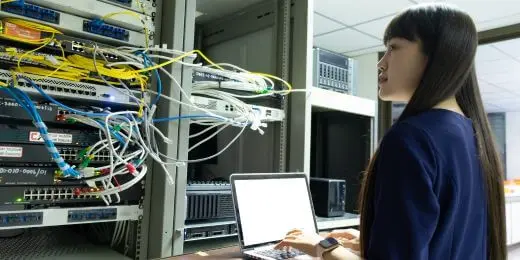What is 3G Shutdown?
The 3G shutdown, or the 3G sunset, refers to the phase-out and discontinuation of third-generation cellular networks by telecommunication providers as they make way for faster and more efficient 4G and 5G networks. It involves decommissioning the infrastructure and radio frequencies used to support the technology, which means that devices relying on it will no longer function properly. To prevent disruptions and provide better services, companies across industries should begin their migration so they can utilize more efficient systems.
Reasons Behind the Shutdown
There are several reasons why the 3G shutdown is happening, but the most evident is that it has become outdated. While it was revolutionary in the early 2000s, establishing wireless technology as we know it today, many require faster data speeds, lower latency, and better network efficiency.
More sustainable 4G and 5G networks offer all those. By shutting down 3G networks, telecom companies can repurpose the spectrum and continue to support the consumer’s growing needs in the future.
Network Shutdown Around the World
The 3G network shutdown process is at different stages around the globe. Some have already completed their closures, while others are continuously postponing their plans to ensure satisfactory finalization.
- United States – Major telecom providers like AT&T and Verizon have completed the US 3G shutdown in February and December of 2022, respectively.
- Australia and New Zealand – TPG/Vodafone began the process in December 2023. Meanwhile, 3G network shutdown in Australia under providers like Telstra and Optus will commence in 2024.
- United Kingdom – 3G shutdown UK schedules greatly vary. EE started in September 2023, while Vodafone is in its final phase this year. O2 recently announced their switch-off in 2025.
- Canada – The country has followed the US market approach as companies like Bell, Telus, and Rogers have begun the 3G network shutdown of Canada in 2022.
- European Union – 3G sunset Europe timelines vary by country and carrier, although many have targeted 2022 and 2023 to transition.
- Asia – Some telecom companies in countries like Japan, South Korea, Taiwan, and Singapore led the way to the tech sunsetting, having started their closure process as early as 2019. Other countries have pushed back their plans to 2024 and 2025.
What will be Affected by the 3G Shutdown?
3G was incredibly groundbreaking. It did not just enable people to communicate in an instant through email, real-time chat, and video calls. It also helped industries automate various tasks, such as medical alert monitoring, vehicle tracking, and contactless financial transactions.
Now that the network will be shut down, all companies relying on it will be greatly affected. Here are some of the major impacts of this ongoing network shutdown:
Operational Disruptions
Transitioning to new network technologies may cause temporary disruptions in service, impacting business operations. Here are some real-life examples:
- Transport and Logistics – Companies rely on GPS tracking services, vehicle diagnostics, and road conditions with traffic updates to deliver goods promptly and on time. Businesses in this sector should understand everything about the cessation of the 3G network and its impact on fleet management and other vital workflows.
- Healthcare – Most hospitals and clinics utilize patient monitoring systems (e.g., pulse oximeters, apnea monitors, EKG machines) to provide care and improve patient outcomes. The loss of connectivity hinders the healthcare provider’s ability to observe their patient’s condition, compromising their safety.
- Retail – The tech sunsetting will also affect the company’s customers and clients. Many are asking the question: Will my phone work after the 3G shutdown? The answer to that is no, which means that many customer service applications (e.g., ordering, payment processing, delivery routing) downloaded won’t function anymore.
Security Risks
Cybersecurity risks continue to be pervasive. When enterprises fail to safeguard their tech architecture as they shift to new tech, they expose themselves to data breaches and other attacks. Here are a few facts companies should be aware of:
- 3G technology has outdated security protocols and is definitely not equipped with the latest features.
- There will be no more updates or technical support as telecoms have shut down 3G tech or are in the process of closing it down.
- Legacy systems will most likely be incompatible with modern security standards.
The closure also negatively affects physical security. CCTV surveillance cameras, perimeter detection devices, fire alarms, and even environmental (CO, CO2, NO2) sensors will fail to transmit vital data if they rely solely on 3G connectivity.
Malicious actors know organizations are scrambling to upgrade or replace their old systems. They will exploit any sign of vulnerability, so companies should carefully strategize and implement these solutions.
Financial Considerations
Any modernization effort will require additional investments. Upgrading or replacing devices can be costly, especially for enterprises with extensive assets. Companies that continue to rely on legacy systems or incompatible applications will have to spend more.
Migration away from 3G technology requires careful planning, budgeting, and strategic decision-making. By adopting a proactive approach and exploring various funding options, companies can successfully allocate the necessary funds and ensure a smooth transition to newer and more advanced technologies.
Facing the Sunset: Effective Strategies for the 3G Shutdown
There is no doubt that the company’s continuous success heavily relies on keeping up with tech advancements, especially in today’s business landscape. Here are some ways that can help an enterprise transition successfully:
Plan the Shift Carefully
Migrating from legacy systems is not just a complex digital transformation. It is also immensely expensive. With only a few months away from the finalized shutdown, companies should start to assess the scope and scale of this project. Take note of the step-by-step process below:
- Review the inventory of all devices, systems, and infrastructure powered by 3G technology transition.
- Estimate the costs associated with the upgrades or replacements by creating a detailed budget and timeline. It would also help to keep track of carriers and their planned termination dates.
- Adopt a phased approach to migration instead of attempting a simultaneous transformation. Conducting a cost-benefit analysis can help with prioritization and resource allocation.
Collaborate with Carriers and Vendors
Engage with service providers to better understand the impact of 3G sunset on their existing services. Telecoms may also provide alternative technologies or have information about possible updates, compatible software options, Internet of Things (IoT) suppliers, and new security protocols.
Because cost is a top consideration, negotiate with service providers about possible discounts on equipment purchases, extended payment terms, and bundled service packages. These can reduce the company’s expenses and help maximize ROI.
Explore SafetyCulture Monitoring Solution
Utilize advanced sensor technology to monitor assets, automate vital alerts, implement actions, and report urgent issues.
Talk to an expertProvide Training for Employees
Educating the entire workforce about the upcoming change, and emphasizing the importance of adapting to new technologies, shows the company’s commitment to the shift. It reduces the possibility of resistance, contributes to a smooth transition, and enhances the organization’s readiness. Here are some topics to include in the program:
- Introduction to the 3G Sunset
- Operational and Financial Impact
- Network Methodology and Prerequisites
- Recommendations for Phase Outs
- Business Case Studies and Real-Life Scenarios With and Without the Shift
Future Proof the Network
The 3G shutdown won’t be the last tech sunsetting. Businesses of all sizes should know how to adopt strategies and practices that ensure their infrastructure can adapt and evolve to the changing trends and continuous advancements.
FAQs about 3G Shutdown
The impending suspension of third-generation networks will affect both businesses and their consumers. As aforementioned, all 3G-powered devices will no longer be able to function once it is off the spectrum. The only option is to upgrade.
There are numerous risks that organizations across industries should be aware of. In fact, implementing robust security measures (e.g., encryption, authentication, and access controls) for protection and compliance with data privacy regulations should be a priority for enterprises.
While details regarding the shift to 4G and 5G have been in the news for several years, many people may still not be aware of its impact on them. Therefore, businesses should inform their patrons and targeted audience about the transition. They can accomplish this through communication campaigns, notification letters, customer support, or helplines.
Many carriers across the globe have already ceased their 3G services and shifted to 4G and 5G since 2020. Only a handful of countries have pushed their deadlines further, such as Bangladesh in 2026, Iceland in 2028, and Greenland in 2029.




